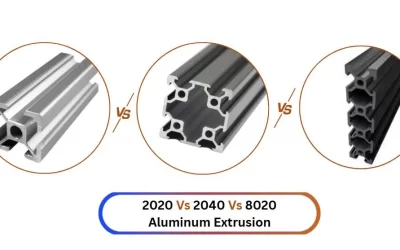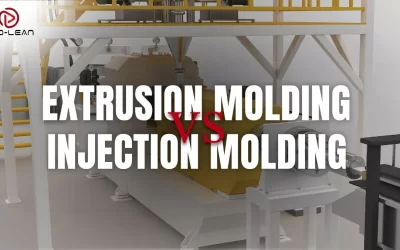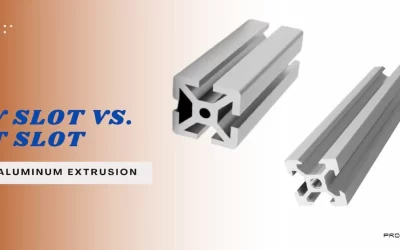Introduction
Aluminum extrusion dies play a crucial role in the manufacturing process of various aluminum products. These dies, made from high-quality steel, are designed to shape molten aluminum into the desired cross-sectional profile. The extrusion process involves forcing the heated aluminum alloy through the die, resulting in a continuous length of material with a consistent cross-section.
Given the importance of aluminum extrusion dies in production, it is essential to understand their characteristics and ensure proper maintenance. One critical aspect of maintaining these dies is polishing (Take a look: polishing guide), which can significantly impact the aluminum extrusion process’s overall quality, efficiency, and cost.
Polishing a die means refining its surface to remove any imperfections, marks, or roughness that may have occurred during manufacturing or use. This helps reduce friction between the aluminum and the die, leading to smoother extrusion and fewer defects in the final product. A well-maintained die also boosts production rates, minimizes downtime, and cuts production costs. In this comprehensive guide, we’ll explore the various aspects of aluminum extrusion die polishing, from types of dies and metal polishing tools to best practices and challenges faced during the process.
What is the aluminum extrusion process?

Aluminum Extrusion Die
The aluminum extrusion process begins with the billet, a solid cylindrical block of aluminum alloy heated to approximately 900°F (482°C). The heated billet is then placed into the extrusion press, where a ram applies pressure to it, forcing it through the die. As the aluminum material flows through the die, it takes on the cross-sectional shape of the die’s profile.
The extruded aluminum then goes through a series of cooling processes, including air or water cooling, to solidify the material and maintain its desired shape. After cooling, the extruded aluminum is cut to length, heat-treated, and finished according to the specific application requirements.
Types of the aluminum extrusion die.
There are three main types of aluminum extrusion dies; each serves different needs.
- Solid Dies: Solid dies create solid aluminum profiles, such as bars, rods, or angles. These dies have a single, unbroken cavity in the desired profile shape. Solid dies are relatively simple in design and commonly used in aluminum extrusion.
- Semi-Hollow Dies: Semi-hollow dies create profiles with a partially enclosed cavity. They have a more complex design than solid dies and feature a partially enclosed cavity within the die that creates a semi-hollow cross-sectional profile. Semi-hollow profiles include channels, tubes with a single internal rib, or extrusions with a partially enclosed void.
- Hollow Dies: Hollow dies create profiles with fully enclosed cavities, such as tubes and hollow profiles with complex shapes. Compared to solid and semi-hollow dies, these dies are more intricate and challenging to design and manufacture. Hollow dies typically utilize a mandrel (or bridge) that supports the profile’s internal shape, ensuring the enclosed cavity’s proper formation during the extrusion process.
The importance of die polishing in aluminum extrusion
Die polishing is an essential step in the aluminum extrusion process, as it directly affects the quality and efficiency of the final product. A well-polished die ensures the smooth flow of aluminum through the die, reducing friction and minimizing the risk of defects. A properly polished die can also prolong the die’s life, reduce aluminum extrusion costs, and optimize overall production efficiency.
Purpose and Benefits of Die Polishing:
Die polishing serves several purposes in the aluminum extrusion process. Some of the primary benefits include:
- Improved surface finish: A polished die produces a smoother extruded product with fewer surface imperfections. This improved surface finish can enhance the product’s appearance and performance, reducing the need for additional finishing processes.
- Reduced friction: Polishing the die reduces friction between the aluminum material and the die surface, allowing the aluminum to flow more smoothly through the die. This reduced friction can minimize material sticking, tearing, or other defects during extrusion.
- Prolonged die life: Regular die polishing can help extend the life of the die by removing surface imperfections and reducing wear on the die surface. This increased die life can lower aluminum extrusion tooling costs and improve production efficiency.
- Optimized production efficiency: A well-polished die can help reduce downtime associated with die maintenance and replacement, improving overall production efficiency.
Try Prolean Now!
Die Polishing Techniques
Die polishing is a crucial step in the die-making process, as it enhances the quality and performance of the final product. There are several die polishing techniques, each with its advantages and applications. The table below comprehensively compares the various die polishing techniques, highlighting their advantages, disadvantages, and best applications. Choosing the most suitable technique depends on die material, geometry, and desired surface finish.
| Technique | Advantages | Disadvantages | Best Applications |
|---|---|---|---|
| Manual Polishing | High precision, and control over the process | Labor-intensive, time-consuming | Small-scale projects, intricate details |
| Mechanical Polishing | Faster, and more efficient than manual polishing | May not be suitable for intricate or delicate features | Large-scale projects, simple geometries |
| Ultrasonic Polishing | Uniform surface finish, suitable for hard-to-reach areas | Requires specialized equipment | Small cavities, complex geometries |
| Electrolytic Polishing | Ideal for complex geometries, with minimal effort | Requires specific electrolyte and equipment | Complex shapes, high-quality finish |
| Electrochemical Polishing | Controlled process, mirror-like finish | Requires specific electrolyte, complex setup | High-quality finish, complex shapes |
| Lapping and Honing | Precise surface finish improves dimensional accuracy | Time-consuming, requires a skilled operator | Critical dimensions, precise finish |
| Chemical Polishing | High-quality finish, minimal effort | Requires specific chemicals, disposal considerations | General polishing, various geometries |
| Abrasive Flow Machining | Consistent surface finish, suitable for complex geometries | Requires specialized equipment, may be expensive | Complex internal geometries |
Here are detailed explanations of these polishing techniques.
- Manual Polishing: This traditional method uses hand tools like files, stones, and abrasive paper to polish the die surface. It requires a skilled operator to achieve the desired surface finish and is ideal for small-scale projects or intricate die details.
- Mechanical Polishing: Mechanical polishing uses power tools such as bench grinders, polishing wheels, and buffing machines to achieve a smooth and shiny surface. It’s a faster and more efficient method than manual polishing, but may not be suitable for intricate or delicate die features.
- Ultrasonic Polishing: Ultrasonic polishing uses high-frequency vibrations generated by an ultrasonic tool to polish the die surface. This method is particularly useful for polishing hard-to-reach areas and small cavities, resulting in a more uniform surface finish.
- Electrolytic Polishing: Also known as electropolishing, this technique uses an electrolytic bath to dissolve the surface layer of the die, leaving a smooth, polished surface. This method is ideal for complex geometries and can achieve a high-quality finish with minimal effort.
- Electrochemical Polishing: This method combines chemical and electrical processes to remove material from the die surface. It’s a controlled process that results in a high-quality, mirror-like finish.
- Lapping and Honing: Lapping uses a flat, abrasive surface and a fine abrasive compound to polish the die, while honing uses an abrasive stone or stick to remove material. Both methods are suitable for achieving a precise surface finish and improving the dimensional accuracy of the die.
- Chemical Polishing: Chemical polishing involves using a chemical solution to dissolve the die’s surface layer, resulting in a smooth and polished finish. It’s a controlled process that can achieve a high-quality finish with minimal effort.
- Abrasive Flow Machining (AFM): AFM uses a viscous, abrasive-laden material that flows through the die cavity under pressure, polishing the surface as it passes through. This method is especially useful for polishing complex internal geometries and achieving a consistent surface finish.
A step-by-step guide to die polishing
Preparation:
a. Clean the die: Before polishing, thoroughly clean the die to remove any debris or residues.
b. Assess the die: Inspect the die for any damage, wear, or surface imperfections that need attention.
c. Choose the polishing technique: Select the appropriate polishing technique based on the die’s material, geometry, and desired surface finish.
Rough Polishing:
a. Select the appropriate abrasive: Choose a coarser abrasive to remove any major imperfections or scratches.
b. Apply the abrasive: Apply the abrasive to a polishing tool, such as a buffing wheel, polishing pad, or sandpaper.
c. Begin polishing: Using the polishing tool, work on the die’s surface in a consistent manner, focusing on areas with imperfections.
d. Inspect the surface: Periodically check the die surface for evenness and progress.
Intermediate Polishing:
a. Switch to a finer abrasive: After removing major imperfections, switch to a medium-grit abrasive to refine the surface further.
b. Apply the abrasive: Apply the finer abrasive to the polishing tool.
c. Continue polishing: Polish the die surface using the finer abrasive, focusing on achieving a uniform finish.
d. Inspect the surface: Check the die surface for a consistent finish and to ensure all scratches from the previous step are removed.
Fine Polishing:
a. Choose the finest abrasive: Select an ultra-fine abrasive for the final polishing step.
b. Apply the abrasive: Apply the finest abrasive to a clean polishing tool.
c. Final polishing: Polish the die surface using the finest abrasive, achieving a mirror-like finish. d. Inspect the surface: Examine the die surface to ensure a consistent, high-quality finish.
Cleaning and Inspection:
a. Clean the die: After polishing, clean the die surface thoroughly to remove any residual abrasive particles or polishing compounds.
b. Inspect the die: Conduct a final inspection of the die to ensure it meets the required surface finish and dimensional tolerances.
c. Apply a protective coating (optional): If necessary, apply a protective coating to the die surface to prevent corrosion or damage during storage or transport.
Tips for maintaining and prolonging die life
- Regular inspections: Conduct frequent inspections of the die to identify signs of wear or damage early, allowing for timely maintenance or repair.
- Proper storage: Store dies in a clean, dry environment to prevent corrosion or damage from moisture, dust, or other contaminants.
- Use of lubricants: Apply appropriate lubricants during the extrusion process to reduce friction and wear on the die surface.
- Temperature control: Monitor and control the temperature during the extrusion process to prevent excessive heat buildup, which can cause die warping or other damage.
- Scheduled maintenance: Establish a regular maintenance schedule for die polishing and other maintenance tasks to ensure consistent die performance and prolong die life.
How die polishing impacts overall product quality
Die polishing plays a crucial role in ensuring the quality of extruded aluminum products. A well-polished die results in a smoother extrusion process and reduces defects in the final product. The following table highlights the impact of die polishing on various aspects of product quality.
| Aspect of Product Quality | Impact of Die Polishing |
| Surface Finish | A polished die yields a smooth and uniform surface finish on the extruded product, reducing the need for post-extrusion surface treatment. |
| Dimensional Accuracy | Polishing helps maintain the accurate dimensions of the die, ensuring that the extruded products conform to the specified tolerances. |
| Structural Integrity | Polishing eliminates surface defects, minimizing the risk of cracks or weaknesses in the extruded product, which enhances its structural integrity. |
| Aesthetic Appeal | A well-polished die results in extruded products with a visually appealing surface, reducing the need for additional finishing processes to improve aesthetics. |
| Reduced Defects | By removing imperfections and maintaining the die’s surface quality, polishing reduces the occurrence of defects such as die lines, surface scratches, or inclusions in the extruded product. |
Challenges and solutions in die polishing
Die polishing is an essential part of maintaining aluminum extrusion dies, but it can also present several challenges. Here are some of the most common challenges and their corresponding solutions:
Maintaining consistent surface finish:
Challenge: Ensuring a consistent surface finish across the entire die can be difficult, especially for complex dies with intricate geometries.
Solution: Use a systematic approach to polishing, starting with a rough polish to remove significant imperfections, followed by intermediate and fine polishing steps to achieve the desired finish. Employing a combination of manual and automated polishing methods, as well as selecting the appropriate polishing tools and compounds, can help achieve consistent results.
Dealing with complex die geometries:
Challenge: Complex die geometries, such as hollow and semi-hollow dies, can be challenging to polish due to their intricate shapes and hard-to-reach areas.
Solution: Utilize specialized polishing tools, such as narrow or tapered stones, to access hard-to-reach areas. In some cases, it may be necessary to disassemble the die for more effective polishing. Develop a clear understanding of the die design and prioritize polishing critical areas that have the most significant impact on the extrusion process.
Minimizing polishing time and resource usage:
Challenge: Die polishing can be time-consuming, which may lead to increased downtime and reduced production efficiency.
Solution: Implement a preventative maintenance schedule to regularly polish dies, preventing the buildup of significant wear or damage. Use the appropriate polishing tools and techniques to optimize the polishing process, and invest in training for operators to improve their polishing skills.
Adapting to new materials and extrusion technologies:
Challenge: New materials and extrusion technologies may require changes to die-polishing methods or introduce new challenges.
Solution: Stay updated on industry advancements and incorporate new techniques, tools, and best practices into the die polishing process. Provide ongoing training and support for operators to adapt to new materials and technologies, ensuring that they are well-equipped to handle evolving polishing requirements.
Best Practices and Tips for Die Polishing
- Use appropriate polishing materials: Select the appropriate abrasive materials and compounds for the specific die material and desired finish quality.
- Follow safety precautions: Ensure that all necessary safety procedures, such as wearing protective gear and proper ventilation, are followed during the polishing process.
- Monitor polishing progress: Regularly inspect the die during the polishing process to ensure that the desired finish quality is achieved and to avoid over-polishing or damaging the die.
- Invest in training: Provide ongoing training for operators and technicians to ensure they are knowledgeable about die polishing techniques and best practices.
- Stay up-to-date on industry advancements: Keep up with the latest developments in die polishing technologies and techniques to continually improve and optimize your polishing processes.
Conclusion
Die polishing is a critical aspect of maintaining and optimizing aluminum extrusion dies. Manufacturers can unlock the full potential of their aluminum extrusion dies by investing in proper die-polishing techniques and maintenance practices. This investment results in higher-quality products, reduced aluminum extrusion costs, and improved production efficiency.
Don’t compromise on quality for your aluminum extrusion dies. Trust our expert solutions and polishing service to enhance performance and efficiency. Request a quote today for all your die needs!
Case studies
Case Study 1: Automotive Industry – Improved Die Life and Surface Finish
A leading automotive manufacturer was experiencing issues with their aluminum extrusion dies’ surface finish and die life. The dies were used to produce aluminum components for car body frames. The manufacturer sought a solution to improve the surface finish and extend the die life.
The die polishing team began by assessing the current surface finishing process and identifying areas for improvement. They implemented a new polishing technique that involved a multi-step process with carefully chosen abrasives and polishing compounds. The new process resulted in a smoother surface finish, reducing friction during the extrusion process.
As a result, the automotive manufacturer experienced a significant improvement in the surface quality of the extruded aluminum components. The new polishing technique also extended the die life by reducing wear and tear, resulting in cost savings due to reduced die replacement and maintenance.
Case Study 2: Building and Construction Industry – Enhanced Productivity and Quality
A building and construction company that produces aluminum extrusion profiles for window and door frames. They faced challenges maintaining consistent product quality and meeting high production demands due to frequent die wear and surface imperfections.
The die polishing experts collaborated with the company to optimize their polishing process. They introduced an advanced die-polishing technique that employed precise polishing equipment and abrasives tailored to the specific aluminum alloy.
The updated polishing process improved the surface finish of the extrusion dies and streamlined the workflow, increasing overall productivity. Due to the enhanced quality of the extruded profiles, the company experienced a significant reduction in product defects and an increase in customer satisfaction.
Case Study 3: Electronics Industry – Improved Heat Dissipation and Performance
An electronics manufacturer specializing in aluminum heat sinks for electronic devices sought to optimize the thermal performance of its products. They recognized that the die-polishing process was critical in achieving the desired surface finish to maximize heat dissipation.
The die, polishing team, worked closely with the manufacturer to develop a customized polishing process for their aluminum extrusion dies. This process incorporated specialized abrasives and polishing compounds to achieve an ultra-smooth, mirror-like finish on the die surfaces.
The improved die-polishing process led to a substantial increase in heat dissipation efficiency for the aluminum heat sinks. Consequently, the electronics manufacturer observed a boost in the performance and reliability of their electronic devices, giving them a competitive advantage in the market.
These case studies demonstrate the significant impact of effective die polishing on the success of aluminum extrusion projects across various industries. By investing in advanced die polishing techniques, companies can achieve improved product quality, increased productivity, and enhanced die performance.
FAQs
What is the purpose of the aluminum extrusion die polishing?
Die polishing improves the surface finish of the extruded aluminum product, reduces friction between the aluminum and the die surface, extends the die’s life, and optimizes overall production efficiency.
What are some common die-polishing techniques?
Some common techniques include manual polishing, mechanical polishing, ultrasonic polishing, electrolytic polishing, electrochemical polishing, lapping and honing, chemical polishing, and abrasive flow machining.
How does die polishing impact overall product quality?
Die polishing contributes to a smoother surface finish, reduces the need for additional finishing processes, improves the product’s appearance and performance, and minimizes defects during extrusion.
What are some best practices for aluminum extrusion die polishing?
Best practices include using appropriate polishing materials, following safety precautions, monitoring polishing progress, investing in training for operators and technicians, and staying up-to-date on industry advancements.
How can die polishing improve production efficiency?
A well-polished die can reduce downtime associated with die maintenance and replacement, improve overall production efficiency, contribute to higher-quality products, lower aluminum extrusion costs, and improve customer satisfaction.





Ich suche nach qualitativen Strangpresswerkzeugen. Daher ist es gut zu wissen, dass es drei Haupttypen dieser gibt. Ich sollte nochmal fragen, welchen ich benötige.
Welches Extrusionswerkzeug Sie benötigen, hängt von Ihren Projektspezifikationen und dem gewünschten Endergebnis ab.
Nice article on aluminum extrusion dies.
Thanks Ciara!